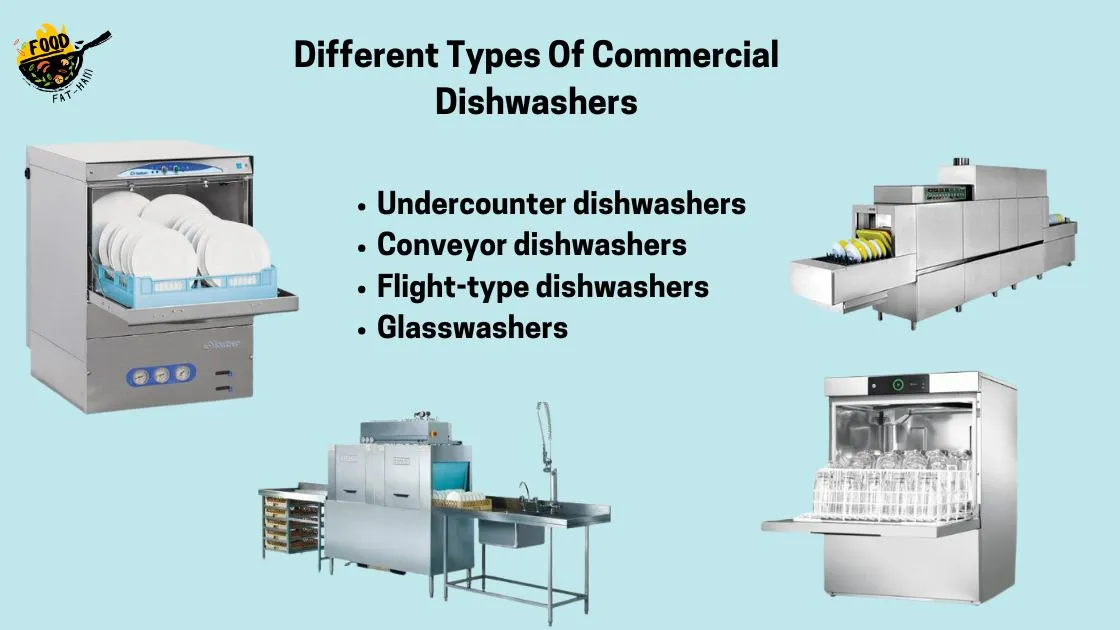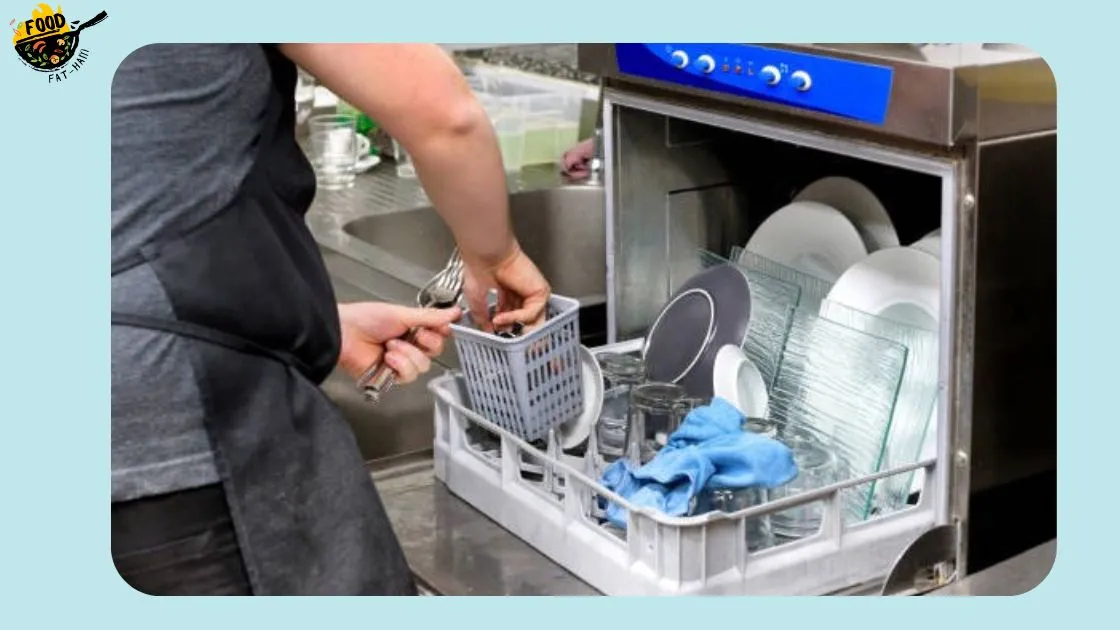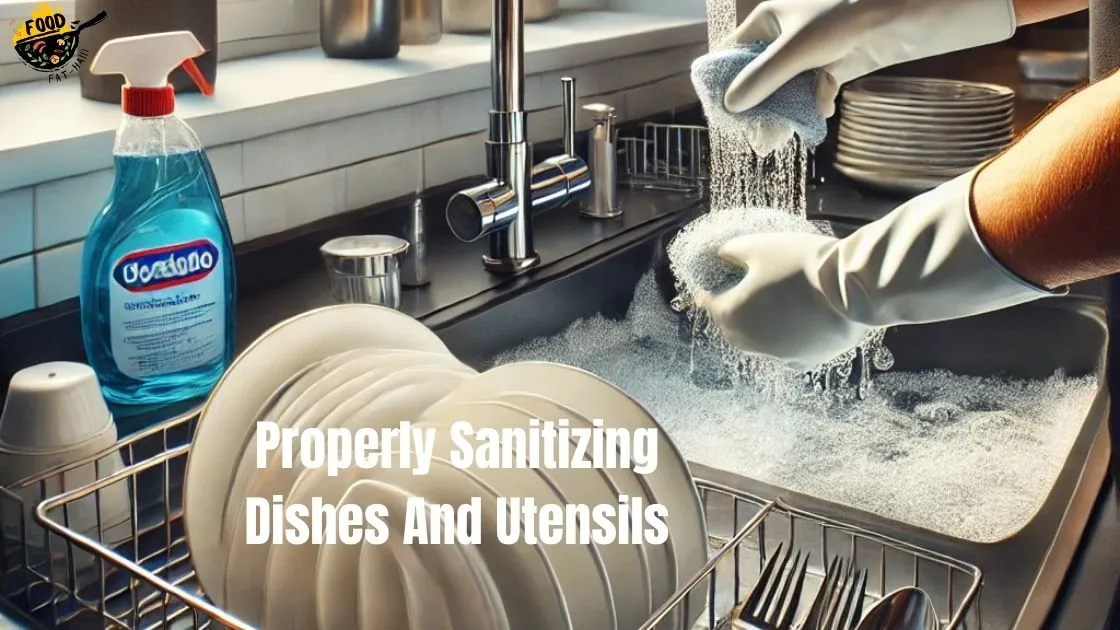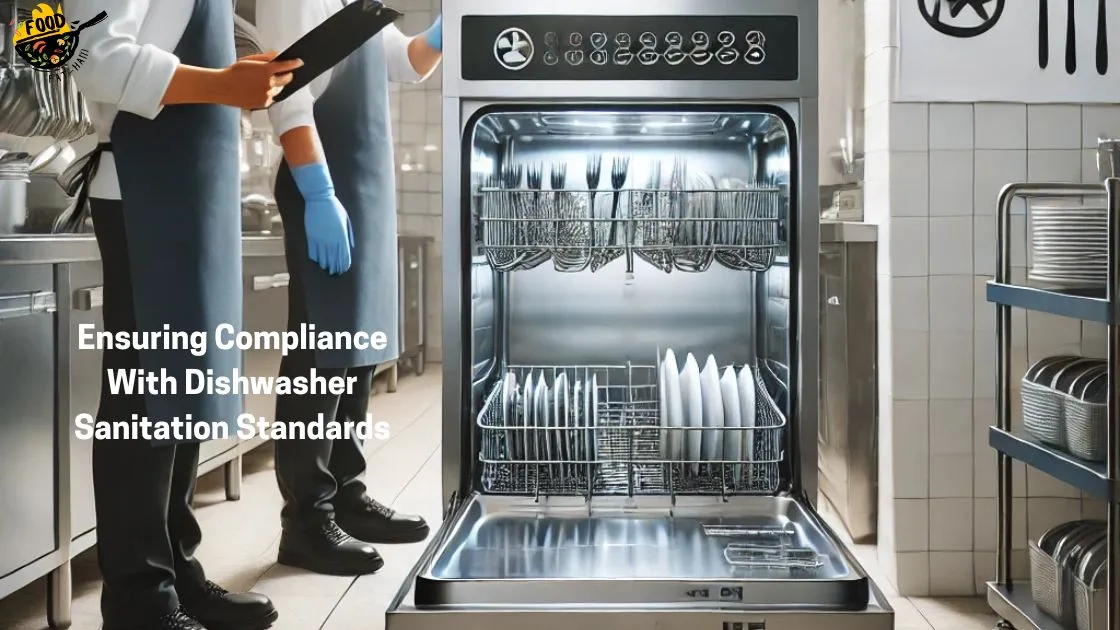To use a commercial dishwasher, load the dirty dishes, select the appropriate wash cycle, and follow the manufacturer’s instructions. Commercial dishwashers are designed to effectively clean large quantities of dishes and utensils in a shorter time compared to household models.
Table of Contents
ToggleIn a busy commercial kitchen, using a dishwasher can save time and ensure proper sanitation. To maximize efficiency, it’s important to load the dishwasher correctly, ensuring that dishes are properly spaced and arranged to allow for thorough cleaning.
Additionally, using the appropriate detergent and following any specific guidelines provided by the dishwasher manufacturer will help maintain optimal performance and prolong the dishwasher’s lifespan.
Understanding The Basics Of Commercial Dishwashers
If you’re new to using a commercial dishwasher, it’s essential to understand the basics. From loading the dishes correctly to selecting the right washing cycles, this guide will help you make the most of your machine and ensure sparkling clean results.
Commercial Dishwashers: An Overview
Commercial dishwashers are an essential piece of equipment for any business in the food service industry, from restaurants to catering companies. These powerful machines are designed to handle the high volume of dishes, glasses, and utensils that need to be cleaned efficiently.
Understanding the basics of commercial dishwashers is crucial for ensuring their proper usage and maximizing their effectiveness. This section will provide a comprehensive overview of commercial dishwashers, covering different types and key features to consider.
Different Types Of Commercial Dishwashers
Commercial dishwashers come in several different types, each suited to specific needs and requirements.

Here are the most common types you’ll come across:
- Undercounter dishwashers: These compact machines are designed to fit underneath countertops and are ideal for smaller establishments with limited space. They offer quick and efficient cleaning cycles, making them suitable for establishments with moderate dishwashing needs.
- Conveyor dishwashers: Perfect for high-volume operations, conveyor dishwashers utilize a conveyor belt system to move dishes through the machine. This allows for continuous washing, rinsing, and drying, which significantly speeds up the dishwashing process.
- Flight-type dishwashers: These large-scale machines are typically found in large food service operations like hotels and banquet halls. With conveyor belts transporting racks containing dishes, flight-type dishwashers can handle significant amounts of items in a single load.
- Glasswashers: Designed specifically for washing glasses, these specialized dishwashers use gentle cycles and low water pressure to minimize the risk of breakage. They often have specific racks or nozzles tailored for glassware to provide optimal cleaning and drying.
Key Features To Consider When Using A Commercial Dishwasher
When using a commercial dishwasher, it’s important to be familiar with its key features to ensure efficient operation and optimal results.
Here are the key features to consider:
- Wash cycle options: Commercial dishwashers offer different wash cycle options suited for specific items such as pots, pans, delicate glassware, and heavily soiled dishes. Understanding and selecting the appropriate wash cycle will ensure effective cleaning while preserving the integrity of the items being washed.
- Water temperature control: Maintaining the right water temperature is crucial for effective dishwashing. Commercial dishwashers provide temperature control features to ensure the water reaches the optimal temperature for cleaning and sanitizing the items.
- Rinse aid and detergent dispensers: Many commercial dishwashers have built-in dispensers for rinse aid and detergent. These dispensers ensure the proper amount of cleaning agents is used, resulting in sparkling clean dishes and glassware.
- Energy efficiency: Look for commercial dishwashers with energy-efficient features to minimize water and energy consumption. Energy Star-rated machines can help save on utility costs while being environmentally friendly.
- Safety features: Commercial dishwashers may have safety features like door interlocks, drainage systems, and automatic shut-offs to prevent accidents and ensure smooth operation. Familiarize yourself with these safety features to maintain a safe working environment.
Understanding the basics of commercial dishwashers, including their types and key features, is essential for anyone involved in the food service industry. By choosing the right dishwasher and using it correctly, businesses can streamline their operations and ensure clean, sanitized dishes for their customers.
Proper Loading And Unloading Techniques
Loading and unloading a commercial dishwasher requires proper techniques to ensure efficient and effective cleaning. Follow these guidelines for optimal performance and to maximize the lifespan of your dishwasher.

Properly loading and unloading a commercial dishwasher is crucial for both efficiency and maintaining the quality of dishes. Organizing dishes efficiently in the dishwasher, loading delicate and fragile items safely, and unloading and storing clean dishes properly are all essential steps to ensure the smooth functioning of your dishwasher.
Follow these guidelines to make the most of your commercial dishwasher:
Organizing Dishes Efficiently In The Dishwasher
Efficiently organizing the dishes in the dishwasher can save time and energy.
Here are some tips to help you achieve this:
Separate dishes by type, such as plates, bowls, glasses, and utensils, to streamline the unloading process. Arrange larger items, like pots and pans, on the lower rack, ensuring they don’t block the water spray arms.
Place smaller items, like cups and small bowls, on the top rack, facing down to allow effective cleaning. Avoid overcrowding the dishwasher, as this can impede water and detergent distribution. Allow adequate space for water to flow between dishes. Alternate large and small items to optimize space utilization and water circulation.
Loading Delicate And Fragile Items Safely
Delicate and fragile items require special care when loading them into a commercial dishwasher.
Here’s how to ensure their safety:
Utilize dedicated racks or compartments specifically designed for delicate items, such as glassware or china, to minimize the risk of breakage. Securely position delicate items, ensuring they don’t touch each other or come into contact with the dishwasher’s interior walls to avoid damage.
Take extra caution with stemware, placing them at an angle to prevent them from touching each other or the dishwasher rack. Use appropriate dishwasher-safe holders or baskets for smaller delicate items like silverware or small utensils. This prevents them from getting lost or damaged during the cleaning process.
Unloading And Storing Clean Dishes Properly
The final step in the dishwasher process is unloading and storing your clean dishes in the most organized and hygienic manner possible.
Here are some tips to follow:
- Begin unloading the dishwasher from the bottom rack first, as the top rack’s items are more prone to water spills when you unload from the top.
- Inspect each dish for cleanliness and ensure that any food particles or residue have been effectively washed off before storing.
- Use designated drying racks or mats to place freshly washed dishes, allowing them to air dry completely before storing.
- Store clean dishes in designated cabinets or shelves, placing them in an organized manner to facilitate easy access and prevent breakage.
- Regularly clean and maintain your dishwasher to ensure optimal performance and longevity.
By following these proper loading and unloading techniques, you can effectively utilize your commercial dishwasher, maintain the cleanliness and longevity of your dishes, and maximize efficiency in your kitchen operations.
Operating The Commercial Dishwasher
Operating a commercial dishwasher is straightforward and efficient. Simply load the dishes, add detergent and rinse aid, select the appropriate wash cycle, and press start. The dishwasher will take care of the rest, leaving you with clean and sanitized dishes.
Whether you run a bustling restaurant or a small cafe, properly operating a commercial dishwasher is essential for maintaining cleanliness and efficiency in your business. By following a few simple steps, you can ensure that your dishes come out sparkling clean, and ready for the next round of service.
In this section, we will walk you through the process of operating a commercial dishwasher, covering three important aspects: preparing dishes for washing, using the appropriate detergent and chemicals, and setting the correct temperature and cycle.
Preparing Dishes For Washing
When it comes to preparing dishes for washing in a commercial dishwasher, there are a few key steps to follow:
- Scrape off excess food: Before loading your dishes into the dishwasher, it’s important to scrape off any leftover food particles. This helps to prevent clogs and ensures that the dishwasher can effectively clean the dishes.
- Sort and arrange: Sort your dishes according to size and material. Stack plates and utensils in the appropriate racks, and make sure that glasses and cups are securely placed in their designated slots. This prevents breakages and optimizes the cleaning process.
- Remove any non-dishware items: Before loading, double-check that no non-dishware items, such as metal scrubbers or kitchen towels, are accidentally included. These items can damage the dishwasher and compromise the cleanliness of your dishes.
Using The Appropriate Detergent And Chemicals
Selecting the right detergent and chemicals for your commercial dishwasher is crucial for achieving optimal cleaning results.
Here are some key considerations:
- Use a commercial-grade dishwasher detergent: These detergents are specifically formulated to handle the tough cleaning challenges in commercial kitchens. They contain powerful enzymes and surfactants to break down grease and food residues effectively.
- Consider additional rinse aids: Rinse aids can improve the drying process and leave your dishes spotless. They help to prevent water spots and speed up the drying time, ensuring that your dishes are ready for immediate use.
- Follow manufacturer instructions: Always refer to the manufacturer’s guidelines for the proper dosage of detergent and any additional chemicals. Overdosing can result in residue build-up and poor cleaning performance, while under-dosing may leave your dishes less than clean.
Setting The Correct Temperature And Cycle For Optimal Cleaning
To achieve optimal cleaning and sanitation, it’s important to set the correct temperature and cycle on your commercial dishwasher.

Here’s what you need to know:
- Adjust the water temperature: Most commercial dishwashers have adjustable water temperature settings. Consult the manufacturer’s instructions to determine the ideal temperature for your specific dishwasher. Generally, hotter water temperatures (around 140°F) are effective in removing stubborn stains and killing bacteria.
- Select the appropriate wash cycle: Commercial dishwashers typically offer a variety of wash cycles, including light, normal, and heavy-duty. Choose the appropriate cycle depending on the level of soiling on your dishes. For heavily soiled items, opt for a longer and more intense cycle to ensure thorough cleaning.
- Don’t forget about sanitizing: Many commercial dishwashers have a sanitizing option, which raises the water temperature to a level that kills bacteria. Use this cycle to ensure that your dishes are not only clean but also safe for use.
By following these guidelines and taking the time to operate your commercial dishwasher correctly, you can ensure that your dishes are consistently cleaned to the highest standards. Properly operating your dishwasher not only saves you time and effort but also helps to uphold the hygiene and reputation of your establishment.
Maintenance And Troubleshooting Tips
Ensure optimal performance and longevity of your commercial dishwasher with these valuable maintenance and troubleshooting tips. Discover how to properly utilize and care for your dishwasher to enhance efficiency and prevent potential issues.
Maintaining your commercial dishwasher is crucial to ensure its efficiency and longevity. Regular cleaning and maintenance procedures, addressing common issues and problems, and implementing certain tips can effectively extend the lifespan of your dishwasher.
Let’s dive into each aspect in detail:
Regular Cleaning And Maintenance Procedures
- Clean the filters: Remove and clean the filters regularly to prevent food particles and debris from clogging the dishwasher and affecting its performance.
- Clear spray arms and nozzles: Inspect the spray arms and nozzles for any blockages or buildup. Use a toothpick or a small brush to clear any debris that may hamper the water flow.
- Descaling the machine: Routinely descale the dishwasher using a recommended descaling solution to remove mineral deposits and maintain proper function.
- Inspect and clean the interior: Check the interior walls, racks, and seals for any residue or buildup. Use a non-abrasive cleaner to wipe these areas clean regularly.
- Check hoses, gaskets, and seals: Inspect the hoses, gaskets, and seals for signs of wear and tear. Replace them if necessary to prevent any leaks and ensure proper functioning.
Addressing Common Issues And Problems
- Poor cleaning results: If your dishwasher is not cleaning effectively, check for clogged spray arms, low water pressure, or worn-out wash arms. Addressing these issues can improve cleaning results.
- Leaks: Inspect the hoses, valves, and seals for any leaks. Tighten loose connections and replace damaged parts to prevent water leakage.
- Water not heating: If the water fails to heat up, it can result in poor cleaning. Check the heating element for any damage and replace if necessary.
- Drainage problems: Ensure that the drain line is free from clogs and that it is properly connected. If the dishwasher is not draining correctly, it may require professional assistance to address the issue.
Tips For Extending The Lifespan Of Your Commercial Dishwasher
- Regular maintenance: Adhere to a consistent maintenance schedule to prevent major breakdowns and costly repairs.
- Load dishes correctly: Properly load the dishwasher, ensuring that dishes are not overcrowded. Overloading can hinder the dishwasher’s performance and lead to poor cleaning.
- Use appropriate cleaning agents: Select the appropriate detergents and rinse aids recommended for your dishwasher model. This prevents damage and ensures optimal cleaning results.
- Avoid excessive pre-rinsing: While it is necessary to scrape off excess food, excessive pre-rinsing can waste water and detergents. Only remove large food particles before loading.
- Professional servicing: Consider professional servicing at regular intervals to identify any underlying issues and ensure your dishwasher operates at its best.
By following these maintenance and troubleshooting tips, you can optimize the performance of your commercial dishwasher and maximize its lifespan. Remember, a well-maintained dishwasher not only enhances efficiency but also reduces the risk of costly repairs and downtime.
Ensuring Safety And Hygiene
Discover how to ensure safety and hygiene when using a commercial dishwasher with this easy guide. Follow these steps to maintain a clean and healthy environment in your kitchen without compromising on efficiency.
Maintaining safety and hygiene is of utmost importance when using a commercial dishwasher. By following proper protocols and implementing effective sanitization methods, you can keep your dishes and utensils clean and create a hygienic environment in your kitchen.
Importance Of Following Safety Protocols
To ensure the safety of users and prevent any accidents or mishaps, it is crucial to follow established safety protocols when operating a commercial dishwasher.
These protocols include:
- Proper handling: Always exercise caution when loading and unloading the dishwasher to prevent injuries. Avoid overloading the machine, as it can hinder proper washing and potentially damage the equipment.
- Correct use of chemicals: Adhere to the manufacturer’s instructions for using cleaning and sanitizing chemicals. Properly measure and mix the solutions to achieve the desired level of cleanliness without jeopardizing anyone’s safety.
- Regular maintenance: Regularly inspect and maintain the dishwasher to ensure it functions optimally. This includes checking for any leaks, cleaning filters, and performing necessary repairs or replacements.
Properly Sanitizing Dishes And Utensils
Sanitizing dishes and utensils effectively is crucial for preventing the spread of bacteria and maintaining hygiene standards.

Here are some key points to consider:
- Pre-rinsing: Before loading the dishwasher, it is essential to pre-rinse the dishes to remove any food residues. This ensures that the cleaning process is more effective and prevents clogging of the dishwasher’s drain.
- Organized loading: Arrange the dishes and utensils properly, ensuring they are not overcrowded or stacked together. This allows the water and detergent to reach all surfaces, ensuring thorough cleaning and sanitization.
- Selecting appropriate cycles: Commercial dishwashers offer various washing cycles for different types of dishes. Choose the appropriate cycle based on the material, level of soiling, and desired level of sanitation.
Creating A Clean And Hygienic Environment In The Kitchen
In addition to following safety protocols and properly sanitizing dishes, it is essential to maintain a clean and hygienic environment in the kitchen as a whole. Consider the following:
- Regular cleaning: Establish a cleaning schedule for the entire kitchen, including countertops, sinks, and other surfaces. Regularly sanitize these areas to ensure they remain free from bacteria and germs.
- Proper storage: Store clean dishes, utensils, and equipment in designated areas to avoid cross-contamination. Ensure that all storage spaces are clean and organized to minimize the risk of contamination.
- Staff training: Train your kitchen staff on proper hygiene practices and safety protocols. Emphasize the importance of handwashing, wearing gloves, and using appropriate cleaning methods to maintain a hygienic environment.
By following these safety measures, properly sanitizing dishes and utensils, and creating a clean kitchen environment, you can ensure the safety and hygiene of your commercial dishwasher.
Energy Efficiency And Cost Savings
Save energy and cut costs by using a commercial dishwasher efficiently. Follow these tips to maximize energy efficiency and reduce expenses while cleaning your dishes.
Tips For Conserving Water And Energy During Dishwasher Use
Load the dishwasher efficiently by arranging dishes, glasses, and utensils properly to maximize capacity per cycle and save water and energy. Scraping off excess food from dishes before loading them into the dishwasher can help reduce the need for pre-rinsing and save water.
Use the dishwasher’s energy-saving mode or eco-cycle, which uses less water and energy compared to regular cycles. Ensure that the dishwasher is fully loaded before running a cycle to optimize water and energy usage.
Avoid using the dishwasher for small loads or items that can easily be hand-washed to save water and energy.
Reducing Operating Costs Through Efficient Practices:
Implement a schedule for regular maintenance of the dishwasher, including cleaning filters, sprayer arms, and seals, to ensure optimal performance and avoid potential breakdowns. Train staff on proper loading techniques to avoid breakage and maximize dishwasher efficiency.
Consider using low-temperature dishwashing chemicals that are just as effective as hot water, reducing energy consumption while maintaining cleanliness. Opt for biodegradable and eco-friendly detergents to enhance sustainability efforts and reduce environmental impact.
Monitor water usage regularly to detect any leaks or inefficiencies and promptly address them to minimize costs and conserve resources.
Upgrading To Energy-Efficient Commercial Dishwashers:
- Invest in Energy Star-certified commercial dishwashers, which are designed to meet strict energy efficiency criteria and can significantly reduce energy and water consumption.
- Look for dishwashers with adjustable settings for water temperature, wash times, and cycles to achieve optimal cleaning efficiency while minimizing resource usage.
- Consider purchasing dishwashers with heat recovery systems, which recycle waste heat from the machine to preheat incoming water, further reducing energy consumption.
- Install flow restrictors on the dishwasher’s water supply lines to regulate water flow and prevent excessive usage.
- Conduct a cost-benefit analysis to assess the potential long-term savings and return on investment of upgrading to energy-efficient dishwashers.
Best Practices For Long-Term Dishwasher Use
Discover the best practices for the long-term use of a commercial dishwasher with these essential guidelines. Keep your dishwasher running efficiently and extend its lifespan with these expert tips.
Training staff on proper dishwasher operation:
- Conduct thorough training sessions with staff to ensure they understand how to operate the commercial dishwasher correctly.
- Emphasize the importance of loading dishes properly, avoiding overcrowding and ensuring each item is positioned correctly for effective cleaning.
- Train staff on the appropriate use of detergent and rinse aid, as well as the correct settings and cycles for different types of dishes.
- Teach staff about safety measures, such as how to handle sharp utensils and hot dishes, and the proper procedure for cleaning and maintaining the dishwasher.
Implementing a regular cleaning and maintenance schedule:
- Create a cleaning checklist for daily, weekly, monthly, and quarterly tasks to ensure the dishwasher stays in optimal condition.
- Regularly clean the dishwasher’s interior, including the wash and rinse arms, filters, and detergent compartments.
- Inspect and clean the dishwasher’s gaskets and seals, removing any food debris or residue that could affect performance.
- Schedule professional inspections and maintenance to address any issues, such as leaks or mechanical problems, promptly and avoid costly repairs.
Monitoring and assessing dishwasher performance regularly:
- Establish a system for regular monitoring of the dishwasher’s performance, including water temperature, pressure, and cycle times.
- Train staff to be vigilant in identifying any signs of poor dishwasher performance, such as dishes not coming out clean or water not draining properly.
- Assess the dishwasher’s performance regularly by conducting water tests to ensure optimal levels of cleanliness and sanitization.
- Keep track of any recurring problems or maintenance needs and address them promptly to avoid unnecessary downtime and ensure consistent dishwashing quality.
Regulations And Compliance
Discover the essential steps for effectively using a commercial dishwasher while complying with regulations and ensuring cleanliness and hygiene in your establishment. Maximize efficiency and maintain regulatory standards with our expert tips.
Understanding Local Health And Safety Regulations
It is essential to familiarize yourself with the local health and safety regulations pertaining to commercial dishwashers.
Ensuring compliance is crucial for maintaining a hygienic and safe environment.
Here are key points to consider:
Obtain the relevant documentation and guidelines from local health authorities or regulatory bodies. Pay attention to specific regulations, such as temperature requirements for washing and rinsing cycles, use of approved detergents and sanitizers, and compliance with electrical and plumbing codes.
Stay updated on any changes or revisions to regulations, as non-compliance may lead to penalties or closure of your establishment.
Ensuring Compliance With Dishwasher Sanitation Standards

Maintaining a high standard of sanitation is critical to the effective operation of a commercial dishwasher.
Here’s what you need to do to ensure compliance:
- Regularly clean and descale the dishwasher according to the manufacturer’s instructions.
- Train your staff on proper loading techniques to ensure dishes, utensils, and glassware are adequately spaced for thorough cleaning.
- Use recommended detergents and sanitizers, following the manufacturer’s guidelines for proper quantities and concentrations.
- Monitor the water temperature during each cycle to verify it meets the required standard for effective sanitization.
- Implement a well-defined schedule for routine maintenance and inspections to identify and address any issues promptly.
Keeping Records And Documentation For Inspections
Maintaining organized records and documentation is essential for demonstrating compliance during health inspections.
Here’s what you should do:
- Develop a system for keeping track of dishwasher maintenance, cleaning logs, and staff training records.
- Regularly update and review these records to ensure they are accurate, complete, and up-to-date.
- Clearly label and store these documents in a designated area for easy access when required.
- Familiarize yourself with the specific requirements of health inspectors regarding record-keeping and prepare accordingly.
- In addition to physical records, consider digital solutions for more efficient data management and retrieval.
Remember, adherence to local regulations, compliance with dishwasher sanitation standards, and maintaining comprehensive records are fundamental aspects of operating a commercial dishwasher in a safe and hygienic manner. By prioritizing these factors, you can promote a healthy environment for your staff and customers while minimizing the risk of penalties or closure.
Frequently Asked Questions Of How To Use A Commercial Dishwasher
How Do You Run A Commercial Dishwasher?
To run a commercial dishwasher: 1. Pre-rinse dishes and load them properly. 2. Add detergent and select the appropriate wash cycle. 3. Start the dishwasher and monitor it throughout the cycle. 4. Remove and inspect the clean dishes before storing them.
What Should You Do To A Commercial Dishwasher?
To properly maintain a commercial dishwasher, follow these steps: 1. Clean the interior and exterior regularly using mild detergent and warm water. 2. Remove and clean filters to prevent buildup and maintain optimal performance. 3. Check and clean spray arms, ensuring they are free from clogs or obstructions.
4. Regularly inspect and replace worn or damaged components, such as gaskets or seals.
Can You Use Regular Dishwasher Detergent In A Commercial Dishwasher?
No, regular dishwasher detergent should not be used in a commercial dishwasher.
What Should Be Done To Dishes Before Loading A Commercial Dishwasher?
To load a commercial dishwasher, follow these steps: 1. Scrape off excess food debris from dishes. 2. Rinse dishes to remove any remaining residue. 3. Arrange dishes properly in the dishwasher racks. 4. Avoid overcrowding the dishwasher for better cleaning results.
Conclusion
Using a commercial dishwasher can greatly simplify the process of cleaning and sanitizing dishes in a busy restaurant or food establishment. By following a few simple steps, you can ensure that your dishwasher operates efficiently and effectively. First, it’s important to pre-rinse your dishes to remove any food debris.
Next, load the dishwasher properly, making sure that the dishes are evenly spaced and not overcrowded. Select the appropriate wash cycle and temperature for the type of dishes being washed. Regularly clean and maintain the dishwasher to prevent buildup and ensure its longevity.
Finally, always prioritize safety by wearing gloves and following manufacturer instructions. Incorporating these tips into your dishwashing routine will help to maintain a clean and hygienic environment, saving you time and effort in the long run. Keep your restaurant running smoothly by mastering the art of using a commercial dishwasher effectively.



